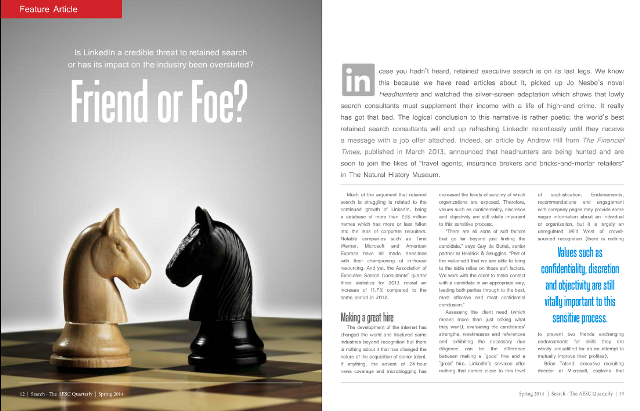Insights
Friend or Foe? Is LinkedIn a Credible Threat to Executive Search or Has Its Influence Been Overstated?
In case you hadn’t heard, retained executive search is on its last legs. We know this because we have read articles about it, picked up Jo Nesbo’s novel Headhunters and watched the silver-screen adaptation which shows that lowly search consultants must supplement their income with a life of high-end crime. It really has got that bad.
The logical conclusion to this narrative is rather poetic: the world’s best retained search consultants will end up refreshing LinkedIn relentlessly until they receive a message with a job offer attached. Indeed, an article by Andrew Hill from The Financial Times, announced that headhunters are being hunted and are soon to join the likes of “travel agents, insurance brokers and bricks-and-mortar retailers” in The Natural History Museum.
Much of the argument that retained search is struggling is related to the continued growth of LinkedIn, being a database of more than 238 million names which has more or less fallen into the laps of corporate recruiters. Notable companies such as Time Warner, Microsoft and American Express have all made headlines with their championing of in-house resourcing. And yet, the Association of Executive Search Consultants’ quarter three statistics for 2013 reveal an increase of 11.7% compared to the same period in 2012.
Making a great hire
The development of the internet has changed the world and fractured some industries beyond recognition but there is nothing about it that has changed the nature of the acquisition of senior talent. If anything, the advent of 24-hour news coverage and microblogging has increased the levels of scrutiny that organizations are under. Therefore, values such as confidentiality, discretion and objectivity are still vitally important to this sensitive process.
“There are all sorts of soft factors that go far beyond just finding the candidate,” says Guy de Buttet, senior partner at Heidrick & Struggles. “Part of the value-add that we are able to bring to the table relies on those soft factors. We work with the client to make contact with a candidate in an appropriate way, leading both parties through to the best, most effective and most confidential conclusion.”
Assessing the client need (which means more than just asking what they want), evaluating the candidates’ strengths, weaknesses and references and exhibiting the necessary due diligence can be the difference between making a ‘good’ hire and a ‘great’ hire. LinkedIn’s services offer nothing that comes close to this level of sophistication. Endorsements, recommendations and engagement with company pages may provide some vague information about an individual or organization, but it is largely an unregulated Wild West of crowd-sourced recognition (there is nothing to prevent two friends exchanging endorsements for skills they are wholly unqualified for as an attempt to mutually improve their profiles).
Brian Toland, executive recruiting director at Microsoft, explains that often the information that an individual has on LinkedIn can be used as a substitute for a resume, something which causes issues for his team. “LinkedIn has become the de facto repository for people’s experience,” he says. “But very rarely do you find a profile that is a decent substitute for a resume. It puts more work on the recruiter because you really need to be digging out the information that a resume would have covered.”
This article was originally published in the first issue of Search Magazine, now renamed Executive Talent Magazine.
